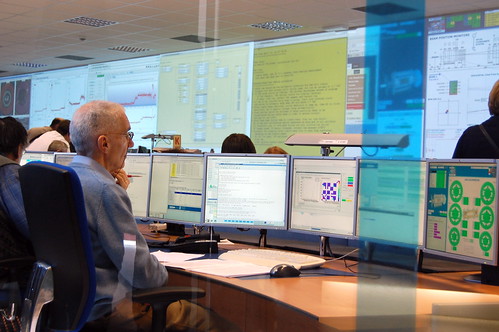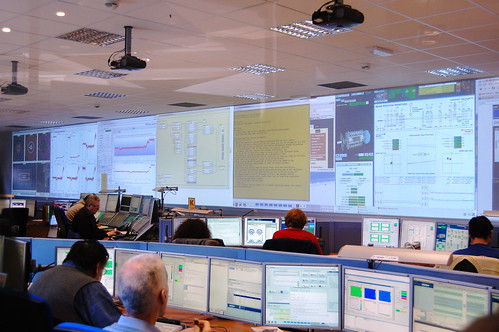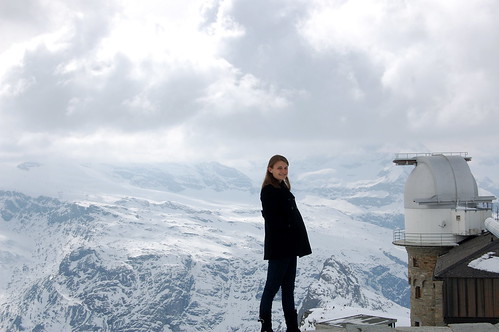Protons, Quarks and Hadrons, Oh My!
- By Faith Tucker
- October 6, 2010
- 1 Comment
[Sara’s note: Even though Faith’s time with us ended back in August (*sniffle*), we were thrilled to get another excellent travel blog from her! That’s dedication.]
You can scour the globe and poke your head in every nook and cranny, but in the end you’ll be hard-pressed to find a place that emanates that giddy, edge-of-your-seat energy (that only the prospect of groundbreaking scientific research can conjure) more than at the CERN headquarters in Geneva, Switzerland. Half of the world’s particle physicists flock to this Mecca of quarks and quadrapoles to study everything from the elusive dark energy to a certain pesky boson named Higgs. But CERN isn’t all esoteric, incomprehensible physics. Well, maybe it is… but that doesn’t mean it’s not fascinating and relevant to us mere scientific mortals.

The “Globe of Science and Innovation” is the landmark of CERN’s headquarters in Geneva.
Photo Credit: Faith Tucker
With the end of World War II, Europe found itself precariously behind the curve in nuclear physics research, and thought perhaps it was time they joined forces on this particular topic. After the obligatory bureaucratic dance, the Conseil European pour la Recherche Nucleaire (CERN) was finally founded in 1954 on the Franco-Swiss border near Geneva, Switzerland and now has 20 member states.
Since those early years, CERN has been a continual source of groundbreaking scientific research. Through a series of increasingly powerful particle accelerators, CERN brought the world its first proton-proton collider, discovered W and Z bosons that transmit the weak nuclear force (earning them a Nobel Prize in Physics), and came up with this little thing we like to call the World Wide Web. In addition to all that, CERN’s newest project, the Large Hadron Collider (LHC), is finally up and running and ready to explain the mysteries of the universe.
The LHC is the world’s largest particle accelerator at 27 km in circumference and is submerged 100 m underground. Once it reaches its full capacity, the LHC will be shooting beams of hadrons around its loop at .9999999991 times the speed of light with the help of over 9000 superconducting magnets at the chilly temperature of -271 C. Colliding two beams of hadrons at these mind-boggling speeds will recreate the conditions directly following the Big Bang and thus help us answer some of the universe’s most perplexing questions.

Just a day in the life at the ATLAS detector’s command center.
Photo Credit: Faith Tucker
These questions that have physicists across the globe biting their nails to the quick in anxious anticipation may not be keeping the rest of us up at night, but perhaps they should… Afterall, have you ever wondered what these mysterious ‘dark matter’ and ‘dark energy’ substances are and how they’re invisibly holding galaxies together and forcing the universe to expand, respectively? Do you ever find yourself passing hours lost in your quandary about what happened to all that antimatter that was created along side normal matter in the Big Bang but seems to have all but vanished since then? And what’s the deal with this whole Higgs field thing, and who gave it the authority to assign mass to the universe’s constituents (if it even exists at all)? With such ominous and fundamental questions as these still looming unanswered over us, I’m not sure how anyone sleeps at all!
During my time last spring in Geneva, I had the opportunity to visit CERN a number of times and pick the brains of some of the genius intellects behind all the madness. I spent one afternoon trying to keep up with the impossibly long strides of my new French physicist friend as we strolled through the labyrinth of hallways of offices in which brilliant minds answer the universe’s most perplexing questions. He showed me all the historic pictures of CERN back in the 50’s, the control room for one of the large detectors for the LHC (the Compact Muon Spectrometer), some of the smaller accelerators (the Low Energy Ion Ring) that build up the particles’ energies before they are injected into the LHC and the laboratory he’s in charge of where they design and make all the vacuum chambers for the LHC. I don’t think I’ve ever said “mmhmm” so many times in so short a period of time – it was practically all I said for the entire two hours I was there as he explained the nitty-gritty of particle physics.

Another view of the ATLAS command center.
Photo Credit: Faith Tucker
On another occasion, instead of a tour I was treated to a coffee in the CERN cafeteria, where seemingly every CERN staff member comes for their afternoon chats. The physicist I spoke to this time came to CERN as a grad student for one year, fell in love with the place and still hasn’t left 36 years later. I sat there listening as he recounted the 25-year history of the LHC (in which he was deeply involved) from its beginnings in casual lunchtime conversations to the previous night’s world record energy, and I realized I was sitting right where those first conversations took place. Over the last 50-plus years, some of the most brilliant minds had sat right where I was, dreaming up the technologies that define the world I live in. And to top it off, a friend of the physicist I was talking to came up to chat, and when he left, my physicist friend leaned over and said, “Do you know who that was? That’s Robert Caillaiu, the co-founder of the World Wide Web.” What?!? Very exciting. I’m definitely going to tell that to my kids some day when the concept of a world without the Internet or the World Wide Web is simply inconceivable.
We continued to talk about the research agendas of the different detectors on the LHC (dark matter and dark energy, anti-matter, super-symmetry, Higgs theory, etc), which I was somehow able to follow more or less and about the next generation of particle collider that would follow the LHC. It was then that I realized, that those very first conversations about the next major record-breaking scientific instrument were probably taking place in that cafeteria around me at that very moment, just as they had for the LFC 25 years ago. I’m going to remember this afternoon for a long time.
So next time you hear something about CERN or the LHC, just picture a cafeteria full of pocket protector-laden, milk carton carrying particle physicists and be thankful that there are actually people out there that have devoted their lives to the study of subatomic particles so that the rest of us can rest assured that there is no nefarious dark energy or antimatter lurking under our beds.

Well, this isn’t at CERN, but there’s a very cool observatory on the top of this mountain and if there were no clouds you’d see the Matterhorn behind me! Switzerland sure does love astronomy. Photo Credit: Faith Tucker
Also check out this great rap about what the LHC does!



OMG those mountains just look majestic!!! What a view!